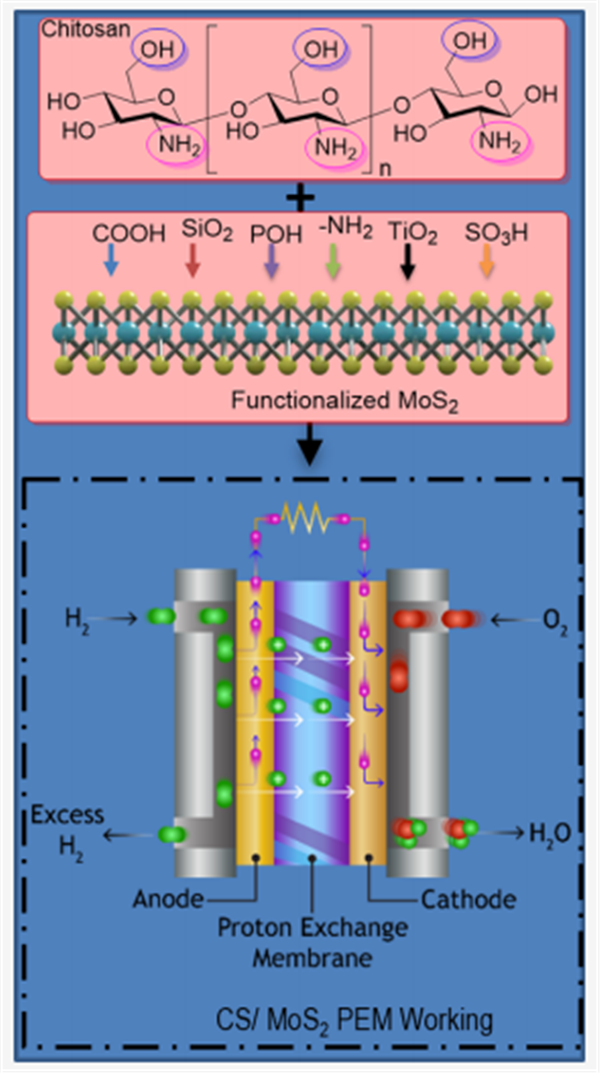Review on Chitosan and Two-Dimensional MoS2-Based Proton Exchange Membrane for Fuel Cell Application: Advances and Perspectives
作者:Saad Ahmed, Zhengyuan Tao, Hao Zhang,Muhammad Hassan,Naveed Ahmed,Muhammad Tariq Javid, Jianli Wang
关键字:Chitosan, polymer electrolyte membrane
论文来源:期刊
具体来源:energy&fuels
发表时间:2023年
壳聚糖是一种天然多糖,具有丰富的生物量资源,因其独特的理化性质而引起人们的关注。壳聚糖的重要性最近有所上升(a)因为它是一种可再生和可生物降解的材料(b)因为它有形成膜的能力。因此,壳聚糖是绿色能源应用的首选。本文介绍了壳聚糖化学的最新进展,重点介绍了磺化、磷酸化、邻苯二酰化和化学交联等元素修饰反应。然而,基于壳聚糖(CS)的聚合物电解质膜(PEM)的主要问题是如何获得高质子导电性、跨燃料电池的泄漏和耐久性。为了克服上述问题,壳聚糖和新兴的一类无机材料二维过渡金属二卤属化合物,特别是MoS2可用于质子交换膜燃料电池的应用。MoS2的表面功能化为CS/MoS2复合膜的制备开辟了新的途径。目前的研究还集中在以下几个方面:(a) PEM的开发策略;(b)壳聚糖在燃料电池应用中的性质和结构;(c)壳聚糖在燃料电池不同部位的应用。本研究还讨论了壳聚糖基质子交换膜面临的进展和特殊挑战。并详细讨论了控制这些问题的策略和未来的发展方向。
Chitosan is a naturally occurring polysaccharide with abundant biomass resources that attracts interest due to its unique physicochemical properties. The importance of chitosan has risen recently (a) because it is a renewable and biodegradable material and (b) because it has the ability to form a membrane. Therefore, chitosan is highly preferable for green energy applications. This review describes the most recent advancements in chitosan chemistry, emphasizing elemental modifying reactions like sulfonation, phosphorylation, phthaloylation, and chemical cross-linking. However, the major issues of the chitosan (CS)-based polymer electrolyte membrane (PEM) are attaining high proton conductivity, leakage across fuel cells, and durability. To overcome the above-mentioned issues, chitosan and the emerging class of inorganic materials 2-D transition metal dichalcogenides especially MoS2 can be employed for proton-exchange membrane fuel cell applications. Surface functionalization of MoS2 can open new pathways for fabricating CS/MoS2 composite membranes. Current research also focuses on the following issues: (a) strategies for the development of PEM, (b) properties and structures of chitosan for fuel cell applications, and (c) chitosan utilization in different parts of the fuel cell. The present study also discusses progress and particular challenges that chitosan-based proton exchange membranes face. Moreover, strategies to control those issues and future aspects are discussed in detail.

本研究由国家自然科学基金(22178317和22109138)、中国博士后科学基金(2020M671790)、中国高等教育委员会和巴基斯坦(Ref. No. 527/ IPFP-II(Batch-I)/SRGP/NAHE/HEC/2020/275)资助。